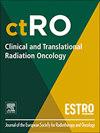Reirradiation with stereotactic radiosurgery for vestibular schwannomas – a systematic review and meta-analysis
IF 2.7
3区 医学
Q3 ONCOLOGY
引用次数: 0
Abstract
Introduction
Stereotactic radiosurgery (SRS) is a widely used treatment modality for vestibular schwannomas due to its non-invasive nature and high tumor control rates. However, some patients experience tumor progression after treatment. In this setting, reirradiation with SRS represents a potential treatment option. This systematic review and meta-analysis evaluates the evidence for reirradiation of vestibular schwannomas with SRS.
Methods
This systematic literature review and meta-analysis investigates the efficacy and safety of reirradiation with SRS for vestibular schwannoma and was conducted following the Preferred Reporting Items for Systematic Reviews and Meta-Analyses (PRISMA).
Results
A total of 806 studies were screened and 35 included, comprising 394 reirradiated patients. The median time from first treatment to reirradiation was 45 months (range: 12 – 65 months). Reirradiation with SRS, applying a median marginal/prescription dose of 12 Gy, achieved an estimated local control of 95% (95% confidence interval (CI): 92 – 97%, I2 = 29.62%, p = 0.10). Trigeminal and facial nerve deterioration rates after repeat SRS were 7% (95% CI: 4 – 10%, I2 = 0.0%, p = 0.44) and 6% (95% CI: 3 – 8%, I2 = 0.0%, p = 0.53), respectively. Serviceable hearing after reirradiation with SRS was rare (5%, 95% CI: 2 – 8%, I2 = 0.0%, p = 0.46). Among patients with serviceable hearing before reirradiation, 43% maintained it after treatment (95% CI: 29 – 57%, I2 = 65.71%, p = 0.00). The risk of bias across all studies was high.
Conclusion
Reirradiation with SRS appears to be a safe and effective salvage treatment for progressive vestibular schwannomas. Prospective studies are warranted to define the optimal dose, timing, and dose constraints for reirradiation.
立体定向放射外科再照射治疗前庭神经鞘瘤-系统回顾和荟萃分析
立体定向放射手术(SRS)因其非侵入性和高肿瘤控制率而被广泛应用于前庭神经鞘瘤的治疗方式。然而,一些患者在治疗后出现肿瘤进展。在这种情况下,SRS再照射是一种潜在的治疗选择。本系统综述和荟萃分析评估了SRS再照射前庭神经鞘瘤的证据。方法本系统文献综述和荟萃分析研究了SRS再照射治疗前庭神经鞘瘤的有效性和安全性,并按照系统综述和荟萃分析的首选报告项目(PRISMA)进行了研究。结果共筛选806项研究,纳入35项研究,其中394例再放疗患者。从第一次治疗到再照射的中位时间为45个月(范围:12 - 65个月)。SRS再照射,中位边际/处方剂量为12 Gy,估计达到95%的局部控制率(95%置信区间(CI): 92 - 97%, I2 = 29.62%, p = 0.10)。重复SRS后三叉神经和面神经恶化率分别为7% (95% CI: 4 ~ 10%, I2 = 0.0%, p = 0.44)和6% (95% CI: 3 ~ 8%, I2 = 0.0%, p = 0.53)。SRS再照射后听力正常的患者很少(5%,95% CI: 2 ~ 8%, I2 = 0.0%, p = 0.46)。在再放射前听力正常的患者中,43%的患者治疗后听力保持正常(95% CI: 29 ~ 57%, I2 = 65.71%, p = 0.00)。所有研究的偏倚风险都很高。结论SRS再照射治疗进行性前庭神经鞘瘤是一种安全有效的抢救治疗方法。有必要进行前瞻性研究,以确定再照射的最佳剂量、时间和剂量限制。
本文章由计算机程序翻译,如有差异,请以英文原文为准。
求助全文
约1分钟内获得全文
求助全文
来源期刊

Clinical and Translational Radiation Oncology
Medicine-Radiology, Nuclear Medicine and Imaging
CiteScore
5.30
自引率
3.20%
发文量
114
审稿时长
40 days
 求助内容:
求助内容: 应助结果提醒方式:
应助结果提醒方式:


